#Sonar Images
Text
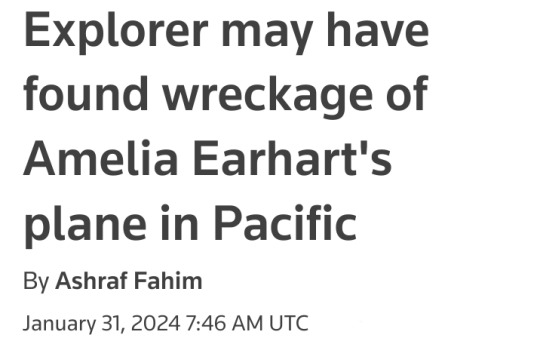





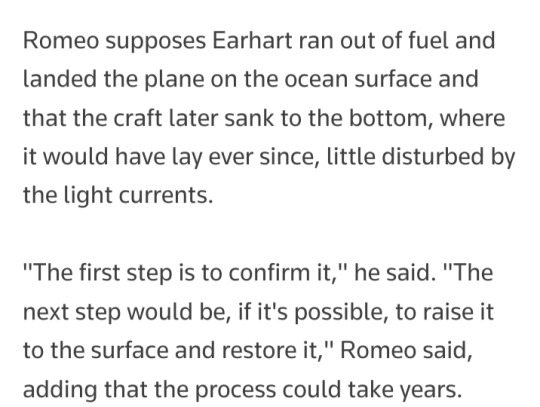


#Amelia Earhart#Pacific Ocean#Atlantic#female aviator#aviation#Charles Lindbergh#Fred Noonan#Deep Sea Vision#Howland Island#deep sea drone#sonar images#Lockheed Model 10-E Electra#airplane#wreckage#Tony Romeo#sonar data#pilot
8 notes
·
View notes
Text
Has Amelia Earhart’s Plane Really Been Found? 6 Key Things To Know
A New Grainy Sonar Image Claims to Solve the Mystery of the Famed Aviator’s Disappearance, But Experts Say it’s Too Soon to tell. Here's What We Do Know.
— By Rachel Hartigan | January 29, 2024
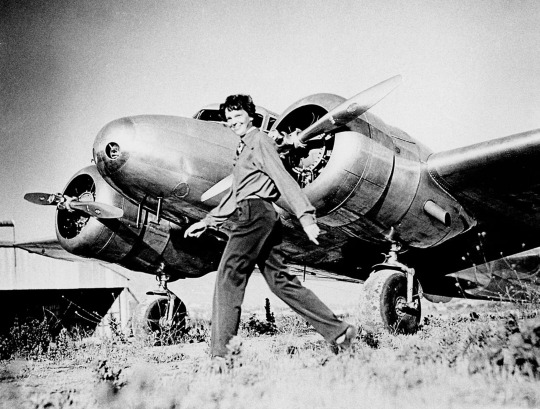
Amelia Earhart and navigator Fred Noonan disappeared over the Pacific Ocean in an attempt to circumnavigate the globe in this Lockheed Electra 10e airplane on July 2, 1937. Experts say it's too early to know for sure whether claims that the wreckage has been found are true. Photograph Courtesy PF-(Aircraft), Alamy Stock Photo
With the Release of a Grainy Gold Image, news headlines around the world are trumpeting the possible discovery of Amelia Earhart’s Lockheed Electra 10e, the plane she was flying in 1937 when she and her navigator, Fred Noonan, disappeared during the most difficult leg of their round-the-world flight.
Deep Sea Vision, a new venture founded by pilot and commercial real estate investor Tony Romeo, captured the sonar image during a hundred-day expedition in the central Pacific, the region where Earhart was lost. “It was definitely a surreal moment for all of us,” says Romeo, who sold his real estate holdings to purchase a cutting-edge autonomous underwater vehicle (AUV) equipped with highly advanced sonar technologies.

The remotely operated vehicle Hercules is retrieved from the waters off Nikumaroro Island onto the deck of the E/V Nautilus in 2019 after a day of searching for Amelia Earhart’s missing airplane. Explorers have long sought to solve the mystery of the famed aviator's fate. Photograph By Gabriel Scarlett, National Geographic Image Collection
Still, it’s too soon to say whether this discovery of an object 16,000 feet deep means one of the great historical mysteries has been solved. Here’s what we do know.
1. Sonar Images Have Limitations.
Sonar images are not photographs. The sound waves sent by sonar are at a low frequency, which translates to low resolution.
“The sound wave, because it’s so big, can’t see fine detail,” says David Jourdan, an engineer whose company Nauticos has led three expeditions in search of Earhart. “It can be distorted by reflections, like taking a picture of a mirror.” Promising images, on a second look, sometimes turn out to be something else entirely, like a geological formation.

Amelia Earhart is shown in the cockpit of her autogiro on April 8, 1931, after setting a new altitude record for women in planes of this type. Bettmann/Contributor/Getty Images
2. Deep Sea Vision Didn’t Confirm The Object’s Identity.
Romeo and his team found the image in their data storage files as they were transitioning to another expedition. They thought that data from one of the AUV’s earlier sorties had been corrupted. When they discovered it wasn’t—and that they had a potential blockbuster find—it was too late to return to the site.
“We were out of time. We were out of resources,” says Romeo. “And we didn’t have a camera on our [AUV]. It broke really early in the expedition.” Returning to go over the target again with just sonar didn’t seem worth the hundreds of thousands of dollars he estimated it would cost. Deep Sea Vision plans to go back to the sonar image site this year, this time with an operational camera on the AUV to confirm the finding.

National Geographic Explorer at Large Bob Ballard, pictured here in the control room of the E/V Nautilus, led a major expedition in 2019 to find the remains of Amelia Earhart's airplane. Photograph By Gabriel Scarlett, National Geographic Image Collection
3. Some Experts Say The Plane, If It Is A Plane, Doesn’t Resemble The Electra.
“The proportions aren’t quite right,” says Jourdan, pointing to the way the wings are swept back rather than straight across, as the Electra’s were.
Others are even more skeptical. “For the wings of an Electra to fold rearward as shown in the sonar image, the entire center section would have to fail at the wing/fuselage junctions,” according to an email blast from The International Group for Historic Aircraft Recovery (TIGHAR), an organization that has put forward the theory that Earhart died a castaway on an island to the east of the sonar image site. “That’s just not possible.”
Romeo dismisses this criticism. Both the wings and the tail look swept back due to distortion caused by the AUV moving through the water, he says, pointing to the twin fins on the back of the plane instead. “That’s very distinctive of her aircraft,” he says. “There’s only a couple of planes that’ve ever been made like that.”

Amelia Earhart is photographed with her Lockheed Model 10-E Electra, the aircraft she used in her attempted flight around the world. Earhart and the plane went missing on July 2, 1937. Underwood & Underwood/Alamy Stock Photo
4. The Object’s Location Is Roughly On Earhart’s Flight Path—But Beyond The Range Suggested By Her Radio Signals.
Earhart and Noonan disappeared on July 2, 1937, flying from Lae, New Guinea, to Howland Island, a one-and-a-half-mile long island some 2,500 miles away. After flying 20 hours, Earhart thought they were close and radioed the Itasca, the Coast Guard ship awaiting them at Howland, “We must be on you but cannot see you.” Her voice was so loud, the Coast Guard radiomen thought she was very near too. She wasn’t, but the strength of the radio signals suggest that she was just beyond visual range.
Deep Sea Vision’s search area was roughly a hundred miles west; Romeo won’t reveal exactly where to avoid someone else making the crucial find. But he does acknowledge that they were guided by a theory that Noonan had failed to account for how the International Date Line would affect his calculations. That theory, however, doesn’t account for the strength of Earhart’s radio signals.

A deep-sea exploration company has captured a sonar image of an anomaly on the ocean floor that resembles an aircraft. The team believes the object could be Amelia Earhart's Lockheed 10-E Electra that went missing nearly 87 years ago. Deep Sea Vision/PR Newswire

Tony Romeo holds a model of Amelia Earhart's plane, which resembles sonar images he and his crew captured with high-tech equipment. Tony Romeo/CEO Deep Sea Vision
5. Others Have Claimed To Solve This Mystery.
Over the nearly 90 years since Earhart and Noonan vanished, many people have claimed to have proof of what happened to them.

Members of the Ballard-led expedition dive in the primary search area just off Nikumaroro Island, an isolated ring of coral and sand surrounding a turquoise lagoon where some suspect Earhart may have been landed. Photograph By Gabriel Scarlett, National Geographic Image Collection
People who believe the Japanese captured and killed the aviators have pointed to everything from a generator retrieved in a Saipan harbor in 1960 to a photograph on a Jaluit dock revealed in 2017. TIGHAR, meanwhile, has claimed various smoking guns over the years but now argues that a preponderance of historical and archaeological evidence puts Earhart on Nikumaroro Island, 400 hundred miles south of Howland, where they believe she starved to death.
Then there’s the simplest explanation: that the aviators simply crashed into the ocean. Elgen Long, an airline pilot who with his wife Marie did the most extensive research into where that might have happened, wrote a book called Amelia Earhart: The Mystery Solved. Over three expeditions, Jourdan has looked where Long suggested (and elsewhere) and come up empty.

6. The Mystery Is Still Unsolved. That Doesn’t Mean Its Unsolvable.
Jourdan’s team believes they’ve narrowed down where the Electra went down based on recent radio signal testing. Meanwhile, when Deep Sea Vision returns to the site this year, they will bring a documentary crew to capture the moment. “This is definitely something that we need to go back and look at,” says Romeo. “We’ve got to get out there before … you know, there is some urgency.”
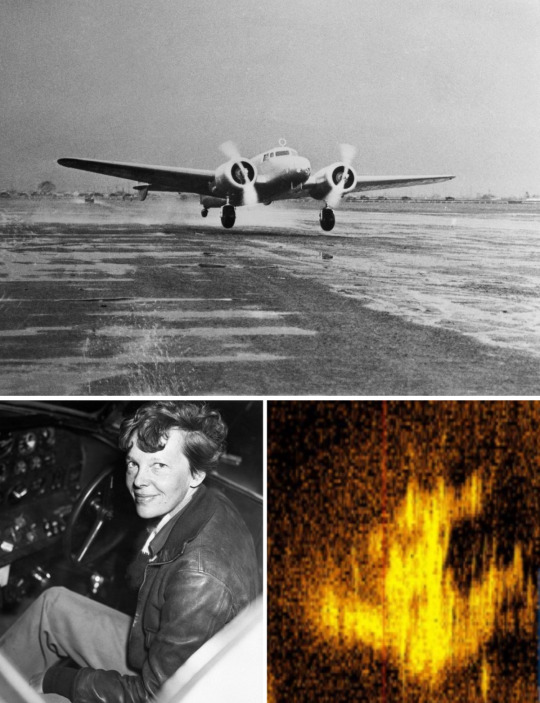
Top: The Romeo Brothers are planning another Pacific Ocean expedition to get better sonar images to confirm whether they have discovered the ruins of Earhart's doomed voyage. Bettmann Archive
Bottom: Deep Sea Vision believes they may have come across Amelia Earhart's wrecked plane in the Pacific Ocean. Photo: Bettman via Getty Images/Deep Sea Vision
Tony Romeo holds a model of Amelia Earhart's plane, which resembles sonar images he and his crew captured with high-tech equipment. (Tony Romeo/CEO Deep Sea Vision)
#History & Culture#Amelia Earhart#National Geographic#Rachel Hartigan#Sonar#Sonar Images#Deep Sea#The Electra#Radio Signals#Object’s Location#Mystery#Still Unsolved
0 notes
Text
1 note
·
View note
Text
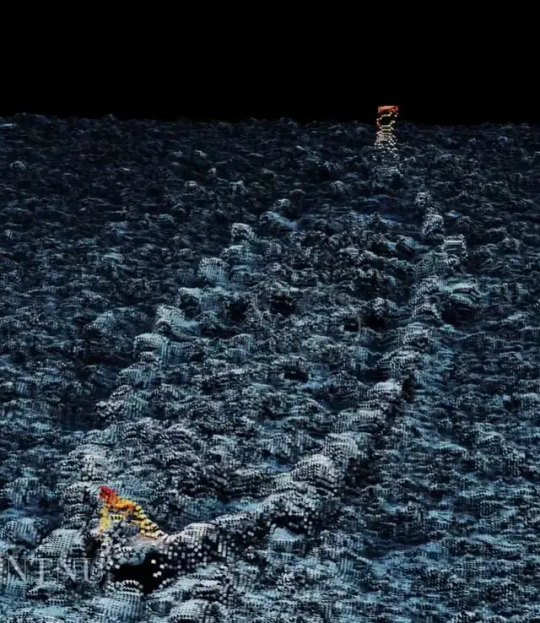
A sonar image of a maybe 700 years old "viking" ship
Archaeologists have discovered the remains of a mysterious ship in 2022 while searching for tonnes of unexploded munitions from WWII that were dumped at the bottom of a lake near Oslo.

So far, there are only sonar images and these show the hull of the 10-metre-long wooden ship at a depth of 410 metres below the surface of Lake Mjøsa, about 100 kilometres north of the Norwegian capital. The fact that it is probably a Viking ship (which must be older then just 700 years, if it is one) can be recognised by the way the ship was built, as it is a clinker construction, and by the shape of the ship itself. What exactly is behind it will become clear after further investigations, which are still ongoing.
162 notes
·
View notes
Text
We went to Loch Ness yesterday and did a boat trip to "look for Nessie". The skipper showed us this sonar image of something they found at the bottom of the Loch:

ooks like Nessie, right?
Turns out, it kind of is Nessie. It's a prop Nessie from The Private Life of Sherlock Holmes. It sank during filming.
112 notes
·
View notes
Text
“Be Your Own Fanartist”


It’s been a HUGE motive for me because-sometimes you just gotta be your biggest fan ^ ^ Try new things! Find influences! Get tips! Only if you want obviously, it’s just what I’ve been doing [Example being the first image :>]
[ Omg Sonar improved sm from here LMAO]
48 notes
·
View notes
Text

Orcas (Orcinus orca) are marine mammals but they’re not technically whales!🐬
While orcas share many characteristics with whales, their taxonomic classification places them in the dolphin family. Specifically, they belong to the suborder Odontoceti, which includes all toothed whales. Their teeth are a defining feature, growing up to around four inches in length.
Physically, orcas resemble their dolphin and porpoise relatives more than traditional whales. They have a more compact body type, similar to dolphins, and their heads don’t exhibit the typical baleen whale shape. Orcas can grow to be up to about 32 feet long, making them the largest of all dolphin species. In comparison, the largest baleen whale—the blue whale—can reach a whopping 100 feet in length!
Odontoceti, including orcas, have the remarkable ability to echolocate. They use biological sonar to navigate in challenging or murky waters. Their heads contain fatty deposits called “melons”, which emit sounds that bounce off objects in their environment.
-----------
Image credit: Carsten Thamdrup
Text credit: Earth of Wonders
75 notes
·
View notes
Text


"Fogbow" & "Fogbow Seen Off the Back Deck" were shot aboard the Okeanos Explorer as part of the Voyage to the Ridge 2022 expedition series:
A fogbow seen over the fantail of NOAA Ship during the transit to the first dive site at the start of the second Voyage to the Ridge 2022 expedition.
NOAA Ocean Exploration published the images (with 200+ others) to the project's online gallery. Also see the Expedition Overview & additional project docs/datasets like Okeanos Explorer (EX2206): Voyage to the Ridge 3 (ROV and Mapping):
Operations during this 28-day expedition included the completion of 9 successful ROV exploration dives in the vicinity of the Azores, the Mid-Atlantic Ridge south of the Azores, and Puerto Rico. ROV dives were conducted in water depths ranging from 250 m to 6000 m for a total of 41 hours of bottom time. EX-22-06 also collected 56,769 square kilometers of seafloor bathymetry and associated water column data using an EM304 multibeam sonar. All data associated with this expedition have been archived and are publicly available through the NOAA Archives.
Somewhere along way, the gallery linked me to Fae Sapsford’s blog post about high seas governance. She’s a Marine Research Fellow at Sargasso Sea Commission & pulled this graphic for her post:

This schematic shows the legal boundaries of maritime zones of the ocean and air space. Image courtesy of Tufts University, Law of the Sea: A Policy Primer, Chapter 2: Maritime Zones.
When I followed the trail to Law of the Sea: A Policy Primer (2017), I found Mehar Kaur’s lovely map designs & uploaded them in separate posts (see here & here).
38 notes
·
View notes
Text
Oh! I found a little image maker!


So I made Elias and I :)
@sonar-fairchild Would you two like to try?
//OOC tags (because this version of Elias and Cordelia Céline haven't interacted with many people yet) @flowers-and-mourning-songs @apartment-413 @little-watcher @elias-magnusnt @fairchild-isnt-my-actual-name
20 notes
·
View notes
Text
so @darlingofdots's awesome Temeraire!universe historian post mentioned the wreck of the HMS Allegiance and I have been thinking about where it is literally all day.
Not just where as in "somewhere in the South Pacific" (because duh) but also, specifically, how deep, and therefore how the wreck would be studied.
Because a lot of archaeologically significant shipwrecks are pretty shallow, since they're the wrecks we can dive to, either on normal air scuba tanks or mixed gas. The Uluburun shipwreck off Turkey, for example, sits between 44 and 61 meters deep, which is right on the edge for air diving. The archaeologists could only be at the bottom for 20 ish minutes at a time, two times per day, with careful decompression timing as they went up to avoid the bends and not-insignificant amounts of nitrogen narcosis at the bottom. Mixed gas goes deeper, 100 meters or so for some of the more available ones. (there's a Phoenician shipwreck off the coast of Malta that's about 110 meters deep, and was excavated by technical divers) Beyond that it's just commercial divers laying oil pipelines with the super $$$ gas at depths of up to 500 meters or so. Anything deeper than that is the domain of submarines and robots.
and really, all of that ^ paragraph is just tangential set dressing that I added because I like shipwreck archaeology, because knowing the Allegiance went down in the middle of the South Pacific meant it was always going to a be a submarines-and-robots wreck. The middle of the Pacific Ocean is uh. deep. but I wanted to find out exactly how deep.

so the map from Crucible of Gold puts the sinking at a little under 50°S and a little over 121°W, which the NOAA bathymetric data viewer says is just about 3000 meters deep

Since that's an extremely boring screenshot, here's the CoG map overlayed on a bathymetric map:

It's actually on a bit of a ridge there! which is why it's at 3000 meters and not deeper.
We do find and investigate wrecks at that depth and deeper these days. The Titanic is at 3800 meters, and it has been investigated extensively (though we also have a recent pretty major news story about why thats still difficult and uh, very dangerous) The USS Samuel B Roberts was found at 6895 meters, and perhaps most relevantly, the search for Malaysa airlines flight MH370 turned up two 19th century shipwrecks at 3500+ meters deep, over 2000 kilometers off the coast of Australia.
One of those wrecks was a wooden ship from either the 1870s or 1880s, and though, being wood, it was pretty badly decayed, its cargo (coal) and metal features (anchor and water tanks) were still extant. On the Allegiance, that would also include her guns and her metal keel (which would probably be the identifying feature TBH, the keel marking her as definitely a dragon transport)
That wreck is probably the best parallel to the Allegiance in other ways, being a wooden sailing ship with a wreck not only very deep but also very remote. It also probably went down due to an explosion, just like the Allegiance. They were common on coal-carrying vessels, and the sonar images showed the cargo was scattered across the seafloor like something catastrophic happened.
The Allegiance would be more remote than its real-world parallel, but anyone looking for it would be hunting for it specifically and would be armed with probably a decent idea of where she was when she went down, seeing as there were survivors who would have been very keen to remember where they were so they could know how close they were to land. Plus, much like the Titanic (though not to the same extent) there'd probably be funding to investigate the Allegiance once found, as she had a part to play in major political turning points on at least three continents. People tend to be interested enough to throw money at that sort of thing.
So, there you have it. It would take a pretty serious effort to find her, though not an impossible one, and once found she'd be investigated by shipwreck robots, which would bring back pictures and samples of her metal remains, with organic matter being mostly absent by the time she was found.
#temeraire#shipwreck archaeology#thank you darlingofdots for the excuse to go down this rabbit hole#you are so correct that in-universe historians would be SO excited for this wreck to be found
91 notes
·
View notes
Text

Chapter 25, "Long Black Terror," of The War of the Hs is up!
"You wouldn't get that sort of performance from a modern car."--Crowley
Aziraphale, Crowley, Neutral Eric, Muriel, and Freddie Mercury must work together to overcome the final obstacles between the group and safety. But can The Bentley overcome her pyrophobia long enough to face Hellfire?
Excerpt under the cut:
Crowley probes ahead with his demonic senses, trying to figure out what’s going on. The burning sea of blood above them is receding back into a river. Satan must be looking for them.
Queenie shows Crowley an image of a broken, rusty pipe protruding from the rocks. He groans. “Oh, no. Not there. Anywhere but there.”
“Where, dearest?”
Crowley groans again as he realizes Aziraphale heard him. “Just be thankful you’re inside the Bentley. Can you see anything besides sand?”
Aziraphale leans forward. His breath kisses the scratched windscreen. “Not yet.”
Freddie sings again. The improvised sonar shows they’re very close to the rocks. The ground shakes again, and rocks slide toward them.
Start from the beginning of The War of the Hs here.
If you're not familiar with the Ineffably Gray series, a GO AU where Aziraphale and Crowley co-anchor a Neutral Alignment, start here with The Language of Forgiveness.
#good omens#good omens fanfiction#good omens fanfic#ao3 link#crowley#aziraphale#good omens au#eric the disposable demon#muriel good omens#the bentley#good omens hell
20 notes
·
View notes
Text

Saw the og image from solar-sonar and its was in my head for like 2 days straight so i had to doodle it....
#gundam#gundam witch from mercury#gundam wfm#wfm#g witch#Suletta Mercury#Miorine Rembran#my art#fanart#doodles#dumb#idk why gave her gun i felt like i guess lmaooo
118 notes
·
View notes
Note
You see people shoot lasers out of their eyes and think nothing of it, but it's a super weird thing that we've just learned to accept. Do you have any idea where the whole "eye beams" thing originates from? Is it Chinese fantasy novels again?

The reason that "eye lasers" or "eye rays" are a common visual image of super powers is because up until a few centuries ago, the way educated people in the middle ages and even Renaissance believed the eye worked was, it was not a receiver of light, but an emitter of light, that is, that the eye was kind of like a car headlight, illuminating what it saw. This was called the emission theory of light, and it had many proponents, including Plato and, notably, St. Thomas Aquinas. One of the strongest pieces of optical emission is that cat eyes glow in the dark, which means the eye may emit light, or at least, emits something that interacts with light from other sources like the sun.

Emission theory of light is the most intuitive way you'd think the eye works. If you are a teacher and you talk to kids about how eyes work, they'll tell you that they think it works because the eye sends out something, like sonar.
The emission theory was disproven during the Golden Age of Islamic Science by Avicenna, a Persian scientist and physicist who invented the first keyhole camera in Isfahan, Iran in the 10th Century. He's definitely one of the most interesting people prior to the scientific revolution.

As for how this got into super-powers, a lot of that comes from who you'd think it would come from: Superman. There are many people who say, based on this or that technicality, that Superman was not the first superhero. This is just pendantic quibbling. Superman is the first superhero in every way that matters, the one who was huge and popular and influential enough to "format the hard drive," as it were, to set the standard of what these things look like going forward.

Heat Vision was the last of Superman's powers to be added, and was only definitively added in the late 1960s. Prior to that, Superman was said to "heat things up with the power of his x-ray eyes." In other words, on occasion, as a power trick or stunt, he could intensify his otherwise passively emitting x-ray vision into something that emits heat the way radiation does. As proof of this, there are many occasions that this was stopped by gold and lead, the way his x-ray vision was. Likewise, Heat Vision was, in the old days visually represented as white until well into the 70s.
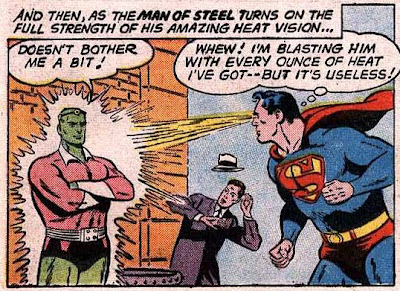
Over time, "heat from his x-ray eyes," thanks to the telephone game, became it's own power. As a young superfan, I remember always arguing the difference with my other Superman loving 13 year old friends about which was more effective: Heat Vision vs. "Superfriction." (I was always on the side of Superfriction as it worked on lead and gold.)

441 notes
·
View notes
Text
USS Monitor
Today marks the 51st anniversary of the discovery of the USS Monitor, a Civil War wreck that lies 16 miles off the coast of Cape Hatteras, North Carolina.
The USS Monitor was an iron-plated warship launched in January 1862. It was built for the Union Navy in an effort to match the Confederacy’s own armored vessel, the CSS Virginia.

While the battle between the Virginia and the Monitor ended with a mutual retreat and no clear victor, news of the battle changed the course of naval history. Many European nations halted the construction of wooden ships, shifting focus to armored designs. Iron and steel would become the new standard for warships around the world.

The low-lying design of the Monitor was well suited for river combat, but fared poorly in the open ocean, particularly rough seas. This would turn out to be the vessel's undoing, and the ship would fall not to the forces of war, but to the forces of nature. It was caught in a storm while being towed on New Year's Eve, 1862, and sank in 230 feet of water.

On August 27th, 1973, 111 years after its sinking, the wreck of the USS Monitor was detected in 230 feet of water using a towed sonar system aboard the Duke University Research Vessel (RV) Eastward. Sonar images did not match the expected shape of the Monitor: this was because it was sitting on the seafloor upside down.
Source
75 notes
·
View notes
Text
"In the murky African riverbeds, eyesight is rendered virtually useless. To navigate their surroundings, some electric fish have evolved a shocking adaptation that challenges our perceptions of sensory intelligence and teamwork in the animal kingdom. Scientists at Columbia University’s Zuckerman Institute recently learned that a species of weakly electric fish (Gnathonemus petersii), also known as the elephantnose fish, shares sensory information within its group almost instantaneously. One fish in the river can instantly tell what lies a far distance in front of it by using the electric field generated by its peers further out.
It’s a remarkable and never-before-seen collective sensing that parallels the collaborative systems used in human-engineered technologies such as sonar and radar."
"Electric brains"
“Think of these external signals as electric images of the objects that nearby electric fish automatically produce and beam to nearby fish at the speed of light,” said Dr. Pedraja. “Our work suggests that three fish in a group would each receive three different “electrical views” of the same scene at virtually the same time,”(...)."
continue reading
#electric universe#electricity#communication#aura#electric field#energy#nature#animals#fish#senses#information#energy generation#biology#signals#science#discovery#organization#collaboration#connection#network
32 notes
·
View notes
Text
here have a thing
warnings: past torture, death mention, bugs mention (mosquitos), blood, associated misery
—
They were, in theory, alone.
The group made their way through what they’d thought was a deserted mangrove. That was the primary reason they’d chosen it as the landing pad for their airship, as the sonar array hadn’t detected any other vessels in the area, nor were there any nearby settlements. They planned it this way so they could avoid coming into contact with any other people.
That was, until they came across the man stumbling through the forest, covered in blood. Leader drew the stun gun from his waist belt and pointed it at the man, who took no notice of them. Friend subtly positioned himself in front of Caretaker, but she could still see the gory images played out in front of her.
The man was alone, and wearing nothing but a tattered pair of work slacks. His chest and feet were bare, save for the grievous wounds that marred them. His body bent forward at the waist, head hanging low, and his muscles contorted with each strangled breath. He’d put his forearm to a tree next to him and seemed to be trying to regain balance or stability or energy or something—Caretaker couldn’t tell. She didn’t know how he was even alive right now.
His head was downturned and his hair, wet and sticky with blood, was so plastered to his skin that his face was indiscernible. Blood streamed down it, as well as from numerous other wounds on his body.
They were…not the sort of wounds one would get from being lost in the forest. They were too precise. Intentional.
“Stay back,” Leader said, in his usual stern but smooth baritone.
The injured man flinched, having registered the sound, but all it did was quicken his breathing. Leader took a step toward him.
Caretaker couldn’t stop staring. Eyes wide, she observed every gash, every burn, every bruise. The wounds were fresh and weeping, but it had to have been a few days at least that the man had been wandering through the forest. He was covered in mud that mixed with the crimson that dripped from his wounds, likely having infected them already. Little red dots scattered across his skin showed that he’d been food for the mosquitos, and small scratches on his arms and legs looked more like the injuries gotten from foliage rather than…direct intent.
How he got the other wounds…Caretaker didn’t want to think too hard about it.
“Who are you?” Leader asked.
The injured man didn’t respond. His arms and legs shook something fierce, and had been the entire time. Whether it was from exhaustion or fear, Caretaker didn’t know.
“Looks like he got pretty fucked up,” Friend chimed in. “He one of ours?”
Leader grumbled something under his breath. “Blackdoor would do that.”
Caretaker pushed herself out from behind Friend and moved quickly up to where Leader was standing. She put a hand on his arm and looked him in the eyes.
“Come on,” she said. “Put the gun down. He’s clearly hurt.”
Leader eyed her stonily. His gaze flicked from Caretaker’s face to the nearly doubled-over body of the injured man and back, though the hand holding the gun never wavered or shook.
“It could be a trap,” he said.
Caretaker put a hand on her hip and used the other to gesture to the mysterious man. “Does it fucking look like one?”
Leader didn’t respond, except to reach to her as she moved forward to go to the injured man. He lifted his head minutely, but with the blood and his hair plastered to his face, she couldn’t make out what he looked like. But she knew he was watching her.
“Hey,” she said. “Do you need help?”
She raised a hand to touch him but he flinched back, stumbling over a root and falling to the ground. Leader shouted and darted forward, and Caretaker felt herself being pulled away from the spot before she could even blink.
She fumbled with the roots and leaves for a bit, but Friend came up behind her and put his arms on her shoulders to steady her. Leader had one foot on the injured man’s chest and was pointing the stun gun directly at his face.
“What are you doing here, Whumpee?” he shouted.
Whumpee. the assassin.
Caretaker shivered. She’d only encountered him once, but she’d been through enough danger at the hands of Blackdoor to know they didn’t mess around and they didn’t hold back.
Whumpee held up his hands over his face. “Pl-please, please, please—you can’t—I’m not—please—I’m—,” he begged, words coming out in short gasps.
His hands shook as he tried to protect himself from whatever he thought was coming. Caretaker could still barely see his face through the blood. Leader didn’t relent, trying to question him on his intentions, but they all already knew what his objective was.
To kill Caretaker.
She stepped up beside him, ignoring Leader’s protests. “What happened to you?”
Whumpee didn’t respond. The begging seemed to take precedence and Caretaker turned to look at Leader, wondering if she had enough persuasion skills to get him to put the gun away.
“You’re hurting him,” she said.
“He was sent to kill you,” Leader said. His eyes blazed with something dark and obsessive. “He fucking killed my brother.”
Caretaker knew Leader had been consumed with revenge ever since the attack that had killed his brother, orchestrated by none other than Blackdoor’s very own assassin. She’d seen the way he stared out the window of the airship as they moved through the sky, the light in his eyes giving way to something else entirely as he talked about how he’d get his revenge. But this wasn’t the way.
She sighed and pinched the bridge of her nose to relieve the building tension. “Yes, I know. I was there. I saw him die on that operating table too,” she began. “But we can’t kill Whumpee here. We can get vital information from him about Blackdoor.”
Friend drew up behind Caretaker and peered around her shoulder to look up at Leader. “And about Team Member! I need to know what he did with Team Member!”
Whumpee groaned, writhing in the mud under Leader’s boot still placed on his sternum. Caretaker glanced down at him and then back at Leader, not wanting to think about how much it must have hurt those bruises staining every inch of skin she could see that wasn’t already covered in mud and blood. Deep purples, blues, greens, and browns made him look more like a piece of abstract art rather than a person.
“…scaped…” Whumpee murmured, almost inaudibly.
Friend crouched down. “What’d you say?”
Whumpee turned his head weakly in Friend’s direction. “He escaped…she let him go…when she caught me.”
He panted heavily, drawing in breaths with great effort. It seemed speaking even this little bit had exhausted him.
Caretaker gave Leader a look that she hoped conveyed to him that he should at least take his foot off the assassin’s chest. Leader understood and acquiesced, stepping back. He didn’t holster the stun gun.
Whumpee took in a deep breath once Leader’s weight was off him, but then immediately whinged in pain. His face crumbled like paper. Friend twisted his mouth to the side, a look of displeased understanding on his face.
“His ribs are probably broken. Sucks to take in a breath when it feels like you’re getting stabbed,” he noted.
Caretaker crouched down next to him. “Who caught you? Did the Eighth Chasm do this?”
The Eighth Chasm leader had a temper to match her fiery red hair. Caretaker would never have expected her to do something like this, but she also had never actually met the woman, so she supposed she couldn’t make such snap judgments. Leader had been the one to feed the information to her, and as much as he liked to think of himself as rational and stoic, he often let his emotions color his perception of things.
Whumpee shook his head, creating a sloshing noise of his hair going back and forth in the mud. “Montrose family,” was all he said before letting the silence hang in the air between the four of them.
Caretaker looked up at Leader, wondering if this was someone new he would tell her about, but his face displayed as much confusion as hers likely did. Leader’s eyebrows knitted together in concentration, but he finally shook his head.
“Is that part of Blackdoor?” Friend asked.
“Why would Blackdoor do this to their own operative?” Caretaker responded to Friend’s question with another question. “It doesn’t make any sense.”
Whumpee heaved another strained breath. His eyelids fluttered, closed, and then opened again after a long pause.
“They didn’t like Blackdoor operating out of New York City…said it was their territory,” Whumpee said. His bottom lip trembled, but he didn’t seem to realize. His eyes glazed over for a moment before he spoke again.
“They sent one of their operatives to kill me and Septimus…hah, and all this,” he gestured at his battered body. “This was just for fun.”
#whump#whump writing#my writing#drops a writing piece randomly in the middle of nanowrimo#i was procrastinating#dont expect anything more lmao#assassin whump#assassin whumpee
70 notes
·
View notes